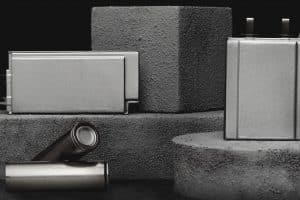Donald Sadoway has been a member of the faculty at MIT since 1978, where he has been teaching a course in solid-state chemistry for the past 16 years. In addition to his teaching duties, he has also been directly involved in research into how to make batteries that cost less than lithium-ion batteries. Recently, MIT announced that Sadoway and his research partners have created an aluminum sulfur battery that may do just that. The research was carried out by scientists at Peking University, Yunnan University, and the Wuhan University of Technology in China; the University of Louisville in Kentucky; the University of Waterloo in Canada; Oak Ridge National Laboratory in Tennessee; and MIT.
The new battery architecture uses aluminum and sulfur as its two electrode materials, with a molten salt electrolyte in between. As the price of lithium skyrockets due to increasing demand, the world needs inexpensive alternatives. Aluminum and sulfur are plentiful and cheap. Sadoway says aluminum-sulfur battery cells will cost about $9 per kWh, which is far less than the lithium-ion battery cells currently available. The new cells are not suitable for use in electric vehicles, but could lower the cost of small-scale storage batteries for homes and small business customers, which could make more lithium-based cells available for the transportation sector. The research has been published recently in the journal Nature.
Sadoway began by studying the periodic table, looking for cheap, abundant metals that might be able to substitute for lithium. Iron, which is becoming an increasingly popular choice, doesn’t have the right electro-chemical properties for an efficient battery, he says. But aluminum — the most abundant metal on Earth — does. “So, I said, well, let’s just make that a bookend. It’s gonna be aluminum,” he says.
Then came deciding what to pair the aluminum with for the other electrode, and what kind of electrolyte to put in between to carry ions back and forth during charging and discharging. The cheapest of all the non-metals is sulfur, so that became the second electrode material. As for the electrolyte, “we were not going to use the volatile, flammable organic liquids” that have sometimes led to dangerous fires in cars and other applications of lithium-ion batteries, Sadoway says.
The researchers tried some polymers, but ended up looking at a variety of molten salts that have relatively low melting points — close to the boiling point of water instead of the nearly 1,000º F for many salts. “Once you get down to near body temperature, it becomes practical” to make batteries that don’t require special insulation and anticorrosion measures, he says.
The three ingredients they ended up with are cheap and readily available — aluminum, no different from the foil at the supermarket; sulfur, which is often a waste product from processes such as petroleum refining; and widely available salts. “The ingredients are cheap, and the thing is safe — it cannot burn,” Sadoway tells MIT News.
In their experiments, the team showed that the battery cells could endure hundreds of cycles at exceptionally high charging rates. The charging rate was closely related to the temperature of the electrolyte. At 110º C (230º F), the experimental batteries charged 25 times faster than they did at 25º C (77º F).
Serendipity Happens
The researchers chose the electrolyte simply because of its low melting point, but it turned out to have a significant advantage. One of the biggest problems in battery reliability is the formation of dendrites — narrow spikes of metal that build up on one electrode and eventually grow across to contact the other electrode. When that happens, it causes a short circuit, which not only hampers efficiency, it can lead to “thermal runaway” — a polite way of saying a battery fire. But the electrolyte they started with turned out to be very good at preventing the formation of dendrites.
The chloro-aluminate salt they chose “essentially retired these runaway dendrites, while also allowing for very rapid charging,” Sadoway says. “We did experiments at very high charging rates, charging in less than a minute, and we never lost cells due to dendrite shorting.”
“It’s funny,” he says, because the whole focus was on finding a salt with the lowest melting point, but the catenated chloro-aluminates they ended up with turned out to be resistant to the shorting problem. “If we had started off with trying to prevent dendritic shorting, I’m not sure I would’ve known how to pursue that,” Sadoway says. “I guess it was serendipity for us.”
Aluminum-Sulfur Battery Needs No External Heat Source
The researchers found the aluminum-sulfur battery they were working on required no external heat source to maintain its operating temperature. The heat is naturally produced electro-chemically by the charging and discharging of the battery. “As you charge, you generate heat, and that keeps the salt from freezing. And then, when you discharge, it also generates heat,” Sadoway says.
In a typical installation used for load leveling at a solar generation facility, for example, “you’d store electricity when the sun is shining, and then you’d draw electricity after dark, and you’d do this every day. And that charge-idle-discharge-idle is enough to generate enough heat to keep the thing at temperature.”
The smaller scale of the aluminum-sulfur batteries would also make them practical for uses such as electric vehicle charging stations. Sadoway says when several electric cars want to charge at once, “if you want rapid charging, the amperages are just so high that we don’t have that amount of amperage in the line that feeds the facility.” Having an aluminum sulfur battery to store power and then release it quickly when needed could eliminate the need for installing expensive new power lines to serve these chargers. Adding batteries to charging stations is already beginning to happen at many locations. The new batteries would significantly lower the cost of adding battery storage to EV charging locations.
The new technology is already the basis for a spinoff company called Avanti, co-founded by Sadoway and Luis Ortiz, which has licensed the patents to the system. “The first order of business for the company is to demonstrate that it works at scale,” Sadoway says, and then subject it to a series of stress tests, including running through hundreds of charging cycles.
Would a battery based on sulfur run the risk of producing the foul odors associated with some forms of sulfur? Not a chance, Sadoway says. “The rotten egg smell is in the gas, hydrogen sulfide. This is elemental sulfur, and it’s going to be enclosed inside the cells.” If you were to try to open up a lithium-ion cell in your kitchen, he says, “the moisture in the air would react and you’d start generating all sorts of foul gases as well. These are legitimate questions, but the battery is sealed, it’s not an open vessel. So I wouldn’t be concerned about that.”
The Takeaway
New battery technologies are cropping up all around the world, but anything with Donald Sadoway’s name attached to it is worthy of consideration. There is a lot of hand-wringing about how invasive mining is and how the quest for battery materials has environmental consequences. (Oddly, ripping the tops of mountains and throwing them into the valleys below to get at coal never seems to draw the same kinds of concerns.) Creating new battery technologies that use some of the most abundant minerals on Earth seems like a no-brainer, if the resulting performance is anywhere near being acceptable for commercial uses.
This research also illustrates how demonizing people who happen to be Chinese could delay critical research needed to address global heating effectively. We are all in this together, and it is going to take all of us working together to keep the Earth habitable for future generations of humans. The need is great and the time is now. Let’s stop bickering with each other and solve the problems that confront us all. That means electing representatives who will support clean energy for all humanity.





